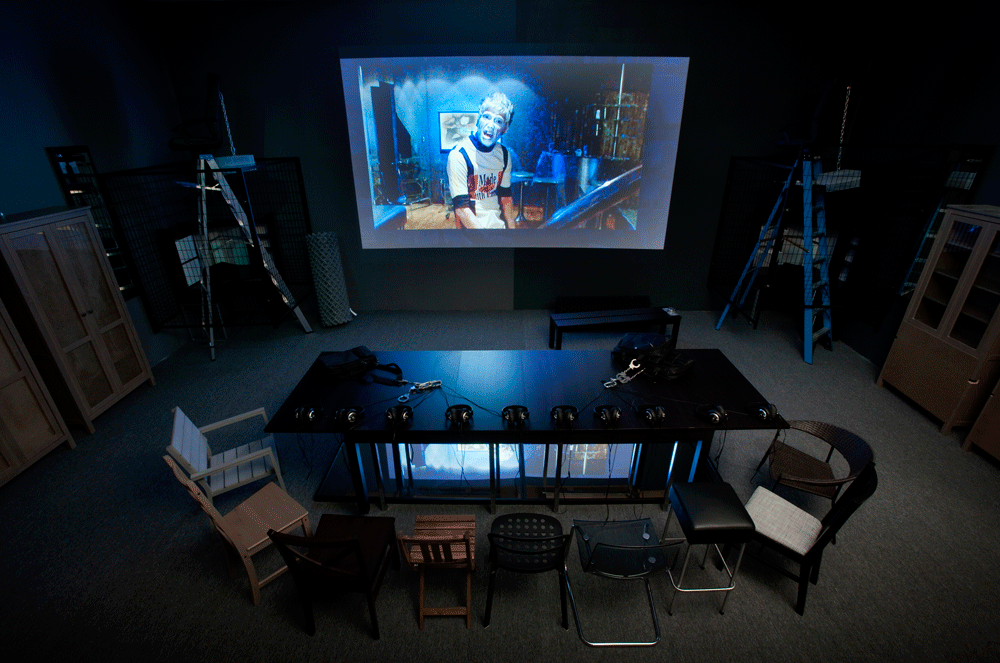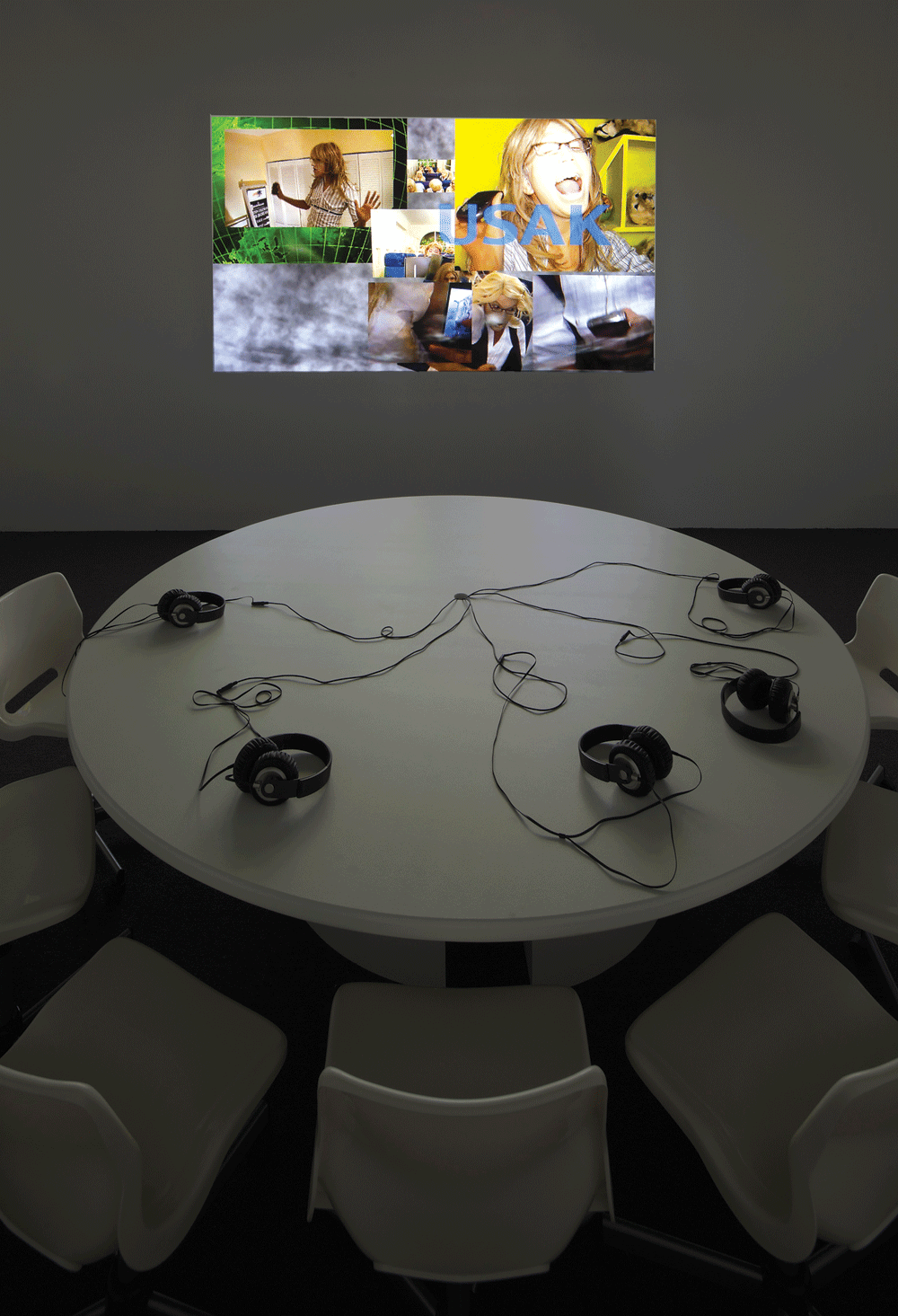
- Source: FRIEZE
- Author: KATIE KITAMURA AND HARI KUNZRU
- Date: OCTOBER 1, 2011
- Format: DIGITAL
Ryan Trecartin: in conversation

Katie Kitamura/Hari Kunzru How do you generate material for your work?
Ryan Trecartin Normally I collect information linguistically – it’s all written down or it’s audio. The visual components are usually linked to linguistics as well: logos, products, graphic design, interfaces. The first stage is script-writing: it usually starts off as a poem or as a list of words, and then I start to think of the script spatially, characters emerge and I consider signifiers, mentalities and accents as forms. As the project gets underway, the script disperses: sometimes the centre drops out and no longer even ends up in the final work. I write alone, but what’s actually shot and edited into the movie is also the product of synergy between the script, situation and performers. Within the work there are platforms for free agency, for people to create something new, for meaning that I never necessarily intended to be there.
KK/HK Lizzie Fitch, who you worked with on ‘Any Ever’, is a long-term collaborator.
RT I’ve been collaborating with Lizzie since we met in 2000 at Rhode Island School of Design. It’s a continuum that’s evolved over the years. I work on lots of her stuff and she works on lots of my stuff. For ‘Any Ever’, everything except the script-writing and the editing is a collaboration with Lizzie – even casting and directing; how we decide to conduct the experience of the night.
KK/HK When you say ‘conduct the experience of the night’, do you mean that you set up a situation and then film what happens?
RT Shoots happen at night because we can control the lighting. We start getting ready as the sun’s going down. We shoot individual lines and segments of scenes over and over, maybe 25 times each. People don’t know what lines they’re going to be saying next. They don’t know their agenda. It’s like writing for a game. Any path could be taken. This keeps the performers in the moment of the scripted line, in a kind of container that is sectioned off from the holistic picture of dramatic motivations. There can actually be more freedom when a performance is decentralized like this; every individual moment becomes the work’s centre, as it occurs. The use of night shooting and artificial light began logistically but, after some of the early works, I realized that it was conceptually useful for the lighting to be controlled: it helped portray a feeling of interior fluid containment, outside of any particular place. As if space could evolve and change at will.
KK/HK The dialogue in the films has incredible flow and momentum. At the same time, there’s a secondary quality to the way your characters express themselves. Even when they’re being intense or dramatic, they’re being dramatic in the manner of a telenovela or a reality show.
RT I think we’re living in a time when you can use more than just words and how they’re strung together to express an idea. Because of the way people read, share and merge information now, the way something is contained and framed is just as valuable as the content inside.

Containment place, 2011, installation view Moma PS1, New York.
KK/HK One of your characters says: ‘My mother accused me of being accumulation posing as independent free will.’ These characters are signs piled on signs. Do you feel melancholy about that? Is there a nostalgia for something lost, or a yearning for authenticity? Or should we be excited?
RT Well, I’m excited. I think it’s a natural extension of how our brains work. It’s just that we have more of an ability to tap into these ways of communicating. Accumulation is an editorial process even if it’s all additive.
KK/HK There’s a layer of corporate globalization that seems to coat your work, but what’s being expressed through all this is an intense, overwrought world. There are grudges and feuds. What’s the role of drama in all this?
RT English has been so influenced by capitalism. Words that etymologically carry neutral connotations have become ‘good’ or ‘bad’ through corporate, legal and other types of disembodied usage. The characters are like projections that come out of these word systems. I think particularly in English-speaking cultures the idea of globalization is decorative. It seems like it’s much more in the realm of spinning and advertising and rhetoric than it is demonstrative of a functioning global community. That’s explored in K-CoreaINC.K (section a) [one of the component videos in ‘Any Ever’]. Everyone’s same-paged in this white-out work face, which is like blank white computer paper, and everyone has these different names of different countries but they’re all basically the same maintenance.
KK/HK There are a lot of systems collapsing in your work: computer systems, credit and banking systems, even language. Is this idea of collapse or entropic decay interesting to you?
RT I think it’s more about celebrating transition as a generative process. People often ask me how come there are no male characters in the work. There is maleness but they don’t see it, because it’s collapsed – it’s a kind of queerness, beyond gender or sexual orientation and toward an erasure of forms of otherness, toward their collapse. If everyone’s individualized and can make decisions, and can composite their identity, there’s no authentic point of origin.

K-CorealNC.K (section a), 2009, HD video still, Installation view, MOCA North, Miami, 2011.
KK/HK There’s a character in the videos who’s just a black hole, over which logos and messages scroll.
…
RT That’s Twi-Key, I was thinking of her as an office-space oracle. The metaphor comes from an editing term, ‘keying’, which is used to abstract a visual structure to enable the compositing of space. The thinking behind it came from exploring the potential need for experiential, cultural, brand and even linguistic translators in the maintenance of work environments, and how the act of translating can be seen as oracular. Think of it like existence as a temporary state of maintaining a situation. As if there are proposed realities that inhabit themselves via structural collaborations and then disperse when they’re no longer needed by the entities involved. These realities then live as versions inside the continuum of translation. The character acts as an affective possibility space as a result.
KK/HK Is that where the word ‘situation’ comes up for you? In one of your films, there’s a copy of the US constitution in which the word ‘God’ is replaced by ‘the Internet’ while the words ‘people’ and ‘humanity’ are replaced with ‘situation’. So, people are just areas or spaces. Is this what ‘I-Be Area’, also the title of your 2007 film, means?
RT We’re all networked and we’re maintaining our own discrete networks of multiple selves, too … and we’re moving towards more corporeal expressions of this. Versions of yourself layered together might actually be an emerging form of collaboration.
KK/HK Bodily contortion, whether of gymnasts or body builders or digital manipulation plays a role. There’s still flesh in here, right? We’re not pure data.
RT As far as the body is concerned, there’s a lot of tension in the videos between the way the characters want to believe their world works and the way it actually works. I like that there’s also friction between the video worlds and the world we live in. I keep this transparent. I’m not creating a world completely divorced from the current human body.
KK/HK How does speed function in the films, particularly as a time stamp in our culture of visual acceleration, an indication of the date when something was made?
RT I like exploiting certain things that I know are going to become dated. Pace is one of these. Every year we acclimate to a faster pace. Also pitch. In pop music the pitch keeps rising. Voices are moving out of human range. I think people are getting behind things that make sense in the moment, without being concerned with transcending time in a grand sense as a creative goal. This thing about transcending time, it’s a little bit like: who cares? It’s as if the momentum and transformative possibilities of information are more important than securing a static legacy.
KK/HK There’s a line in the Sibling Topics section of ‘Any Ever’:‘I can’t go outside because that hasn’t been rendered yet.’
RT The characters are constantly negotiating ideas that I conceive of as architectures: their reality as an architecture, their being as an architecture. The space surrounding these structures is speech; reciprocally, articulation creates space. So, the characters are in the space of speech. Space is a translation of language, of information. Characters are always declaring things to explore and define where they are situated, to find out if they’re participating in the same architecture; to find out if they’re collaborating or not.
KK/HK You did a fashion spread where you have a ‘facial steering wheel’. You say it’s for navigating memory. Elsewhere you have this retroactive notion of adjusting the past from the future.
RT The future and the past can be equally malleable; I don’t think they go in opposite directions. Memory is more an act of memorizing than recalling: you’re creatively constructing something that doesn’t really exist behind you, it exists in the same place the future exists. In my videos the characters try to treat that idea as fact.

